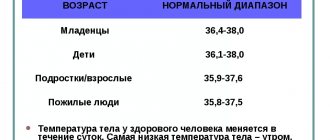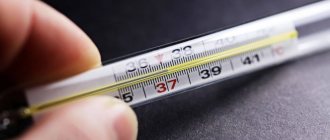Fever is one of the main symptoms of acute respiratory viral infection. Most often it stays in the range from 37 to 38.5 degrees, and rises gradually, not spasmodically, as with the flu.
An increase in temperature during ARVI is a protective reaction of the body to intoxication. Its goal is to create unfavorable conditions for viruses that enter the blood. Subfebrile and febrile temperature
- stimulates the immune system;
- activates the production of antibodies;
- promotes the synthesis of interferon in the body;
- stops the proliferation of viruses and bacteria;
- has an antitoxic effect.
This is why doctors do not recommend taking antipyretics until the thermometer shows 38.5°. Otherwise, the recovery period increases, and the sick person becomes a source of infection for others.
How long does the temperature last for ARVI?
Typically, fever lasts no more than three days. The speed of temperature normalization depends on factors such as:
- level of immunity;
- the presence of inflammatory processes in the body;
- type of pathogen;
- timely treatment started.
If the temperature does not decrease for five days or more, there is reason to assume that the patient has the flu. In this case, qualified medical assistance is necessary.
You should also be wary when the temperature drops on the second or third day, but after some time it rises again. This indicates the addition of a bacterial infection.
Fever in a child: how to bring down the temperature
Why does the temperature rise during illness?
The body has its own “climate control” system, which is responsible for the constancy of body temperature. During inflammation, substances are produced that change the settings of the thermoregulation center, and the temperature begins to be maintained at a higher level. This makes a certain sense: in conditions of elevated temperature, bacteria and viruses feel less comfortable, and the immune system, on the contrary, begins to work more actively. This is a fever - with its help the body fights infection. Fever should be distinguished from heatstroke - there is no protective meaning in it, and the temperature rises due to the fact that the body simply does not have time to cool down (usually due to heat, physical stress and lack of water).
What temperature is considered normal?
Body temperature is very variable and depends on age (the younger the child, the higher his temperature), time of day (usually higher in the evening), physical activity, and also on the method of measurement - thus, the 36.6 ° C familiar to everyone is very arbitrary and There is simply no single standard.
How to measure temperature?
We are accustomed to measuring temperature under the armpit; in many countries, measurements are taken in the mouth or rectum (these indicators are higher). Electronic thermometers are preferable to mercury thermometers - but it must be borne in mind that in order to get an accurate result after the sound signal, you need to leave the thermometer for a few more minutes. Not everyone does this, and therefore the indicators of an electronic thermometer are sometimes unfairly considered to be underestimated. There are also ear and non-contact infrared thermometers, but their readings are not highly accurate.
When should the temperature be lowered?
In itself, high temperatures up to 41 ° C are not life-threatening. The temperature needs to be brought down if the child feels unwell, and the numbers on the thermometer are of secondary importance. If a child has chronic diseases, then it is worth discussing this issue with the attending physician in advance, and if a high temperature appears in a baby under three months old, this is a reason to call an ambulance. In all other cases, you should focus on the child’s well-being: if he is lethargic, complains of a headache and general malaise already at 37.9 ° C, you have the right to give an antipyretic drug. And if a child can barely sit still with a thermometer, you should not run after him with medicine, even if the thermometer reads almost 39 °C.
Many people think that the higher the child’s temperature, the more dangerous and severe the infection he faces, but this is not entirely true. The immune system has not yet fully formed and attacks any infections with all its might. This is why a child’s temperature can rise significantly with a banal ARVI, while this usually does not happen in adults.
How to lower the temperature correctly?
First of all, you need to make sure that the child drinks a lot and does not overheat additionally - to do this, you need to remove excess clothes and blankets from him and open the window slightly so that the room is not stuffy. You can wipe with warm (not cold) water - the cooling effect is achieved due to the evaporation of water from the surface of the skin. And finally, if you feel unwell, you can give an antipyretic drug - it will return the thermoregulation center to maintaining the original, normal temperature. The most effective method is to give an antipyretic, and after half an hour, wipe the child with water.
The only two medications allowed for children with fever are ibuprofen and paracetamol (acetaminophen). They are available in the form of suppositories and syrups under different trade names.
The dose is calculated by weight, not by age of the child.
Ibuprofen: single dose - 10 mg per 1 kg of child's weight. Can be given every 6 hours no more than 4 times a day.
Paracetamol: single dose - 10-15 mg per 1 kg of child's weight. Can be given every 4-6 hours, but no more than 4 times a day.
The drugs begin to act 30-60 minutes after administration and reduce the temperature by about 1-2 °C (and not up to 36.6 °C), while improving well-being. If more than 3 hours have passed after taking one of them, and there is no effect, you can change the drug and start using another, but do not alternate them each time.
When to call an ambulance?
Fever itself is not a reason to panic. It is better to seek emergency medical help if there are so-called red flags:
- disturbance of consciousness, convulsions;
- dehydration (lack of urination, tears when crying, dry mucous membranes);
- breathing problems (sharp increase in frequency, difficulty breathing, appearance of uncharacteristic sounds);
- the appearance of a rash that does not fade when pressed (if you press a glass glass tightly to the site of the rash, the rash remains bright);
- severe headache even after taking antipyretics;
- incessant vomiting;
- persistence of poor health and fever of more than 40 ° C after taking antipyretics;
- acute abdominal pain;
- age up to 3 months.
All other situations most likely do not require emergency assistance. So, if ear pain appears, you can give your child a painkiller (the same ibuprofen) and calmly wait for the pediatrician. But if you think that something is wrong with your child and he is behaving unusually, you should take your child to the doctor as soon as possible.
What not to do?
It is strictly forbidden to use aspirin as an antipyretic in children due to the risk of a fatal complication - Reye's syndrome. In addition, you cannot:
- give analgin and soluble combination drugs “against colds” (like Theraflu) as an antipyretic;
- rub with alcohol and vinegar due to the risk of poisoning (the permeability of children's skin is higher than that of adults);
- wrap the child up and wait for him to sweat;
- use mustard plasters due to the risk of burns;
- take antibiotics on the third day of fever. There are many viral infections in which the temperature lasts longer than 5 days. If the fever persists, you need to see a pediatrician rather than take antibiotics.
Don’t just take your child’s temperature, just in case he’s healthy. If something is wrong with your child, you will notice it without a thermometer. Believe me, it is very easy to see that a healthy child’s temperature is above 37 °C. Coping with your anxiety and making sure that this temperature is normal for him is much more difficult.
And finally, there is no need to panic. Fever is an everyday thing. A sick child needs a calm mother who will give him something to drink if necessary, give him medicine, wipe him off with a damp towel and just be there.
Is there ARVI without fever?
In some cases, a respiratory viral infection occurs without fever. There are a number of reasons why this is possible.
- Strong immunity, thanks to which the body copes with viruses without fever.
- Weakening of defenses, which is often found in older people and those who suffer from chronic inflammatory diseases.
- A weak virus that does not produce enough toxins for the body to react.
- Features of strains. For example, rhinovirus releases toxins that block receptors in the nervous tissue, which disrupts the functioning of the thermoregulation center.
When a fever becomes dangerous
An increase in temperature in itself can pose a health hazard depending on individual characteristics. Thus, patients of any age with organic lesions of the central nervous system (trauma, tumors, vascular changes, consequences of perinatal pathology) can be very sensitive to the adverse effects of hyperthermia.
An increase in temperature increases metabolism in all tissues, including the brain. Nerve cells need more oxygen, and virus-affected or narrowed vessels cannot meet their needs. In addition, against the background of fever, the production of cerebrospinal fluid may increase, and the outflow may become more difficult.
Hypoxia and compression of the brain causes severe headaches, impaired consciousness, and the appearance of convulsions. Young children with a hereditary tendency to epilepsy or a history of perinatal pathology are predisposed to the development of so-called febrile seizures - seizures occur against the background of an increase in temperature and are often accompanied by loss of consciousness.
For expectant mothers, a high temperature or one that persists for several days also poses a danger. Influenza in the early stages can provoke spontaneous termination of pregnancy; in the first trimester it causes developmental anomalies and deformities, and later – toxic damage to fetal organs and disruption of uteroplacental blood flow. Among the most common child diseases:
- heart defects;
- damage to the organs of hearing and vision;
- mental retardation;
- developmental anomalies of the skeleton, skull, anterior abdominal wall.
Answering the question whether it is possible to lower the temperature during the flu, infectious disease specialists talk about patients for whom fever is especially dangerous:
- pregnant women with fever over 38.5 °C;
- children with complaints of lethargy, weakness, a history of convulsive syndrome at a temperature of 38 °C;
- adults with poor tolerance to body temperature above 38 °C (subjectively feel a significant deterioration in their condition, suffer from severe muscle and joint pain, headaches).
What are acute respiratory infections and acute respiratory viral infections?
Both diseases are acute inflammations of various organs of the respiratory system, caused by various infections. Acute respiratory disease - acute respiratory disease - a broader name that is used when the viral component has not been established. And ARVI is an acute respiratory viral disease - when the clinical picture is clear and it is known for sure that the infection is caused by a virus. There are several such viruses: influenza, parainfluenza, respiratory syncytial infection, rhinovirus and adenovirus infection and others. Most often, the disease begins with an elevated temperature. Then it may be supplemented by headache, general weakness, fatigue, aching bones, redness of the pharyngeal mucosa, pain when swallowing, dry cough and nasal congestion. Among the troubles that accompany acute respiratory infections is the addition of a bacterial infection to the disease, which causes complications.
How and when to lower your temperature
When dealing with fever, patients should be divided into 2 categories:
- those for whom rising temperatures pose a danger to life and health;
- all the rest are sick.
Treatment of influenza often begins on an outpatient basis: a person comes to an appointment or calls a doctor at home. An examination by a specialist allows you to assess the severity of the patient’s condition and the possibility of further progression of the disease. If the therapist (or pediatrician) decides that the patient is being treated at home, he explains what to pay attention to, how often the temperature should be measured, and what medications and non-drug medications can be used to reduce it. If a serious condition is suspected, or a rapidly developing deterioration in health, the doctor will suggest hospitalization in the infectious diseases department.
Medicines to reduce fever
According to the protocol for managing a patient with influenza, medications to combat fever are prescribed along with antiviral drugs. The selection of the drug depends on age and individual characteristics.
For adult patients, the following are primarily recommended:
- acetylsalicylic acid;
- ibuprofen;
- naproxen.
If they are insufficiently effective, an increase in neurological symptoms (severe headaches, dizziness), or disturbances in the functioning of the cardiovascular system, a second drug with an antipyretic effect is added - paracetamol or analgin. Questions about the frequency of administration and daily dosage should be discussed with your doctor. He will explain whether it is possible and necessary to lower the temperature during influenza (or ARVI) to 36 °C. Somatically healthy adult patients are recommended to take medications for hyperthermia above 38.5 °C.
Pregnant women receive treatment only under the supervision of a doctor. You should immediately consult a specialist if you have symptoms such as:
- poor tolerance to fever;
- fluctuations in blood pressure;
- abdominal pain, increased uterine tone;
- cessation or intensification of fetal movements.
The condition of children should be assessed more carefully, as they may tolerate fever less well; even in the absence of obvious neurological problems, they are more likely to experience episodes of impaired consciousness and convulsive syndrome. In addition, the ratio of body area to weight in children is greater than in adults: against the background of high temperature, dehydration begins earlier. Another criterion for the use of antipyretics in pediatric practice is the reduction or cessation of sweating in a child due to fever.
If a bacterial infection is suspected, the doctor will prescribe an antibiotic. You should not “carry out prevention” on your own.
Non-drug remedies for fever
Physical remedies can also help cope with hyperthermia. These include: drinking, temperature conditions. Here are the basic rules:
- The room temperature should not exceed 22 °C, the room should be ventilated regularly. To combat dryness, spraying water in the air and humidifiers are used.
- The patient should not be wrapped up; if the temperature drops and there is profuse sweating, the clothes are changed.
- In case of high fever, wiping with a towel soaked in warm water is acceptable. A warm shower is recommended for children. Moisture evaporates from the skin and lowers the temperature. The use of vodka, vinegar, or rubbing with a dry towel is unacceptable.
- A patient with the flu loses a lot of fluid, which leads to increased intoxication and worsening of the condition. To remove decay products, it is important to drink at least 2 liters/day. It is necessary to give preference to plain water, fruit drink, compote.
An increase in temperature during influenza helps the body localize and destroy the virus. In case of severe fever and poor tolerability of the condition, the patient needs to be prescribed drug therapy. You should immediately consult a doctor if your condition continues to worsen even with treatment.
Everyone remembers the doctor's joke: a cold, if treated, goes away in seven days. And if not treated, then within a week. But if your child has been sniffling and coughing for several weeks, you should be concerned. Viruses that cause acute respiratory infections and acute respiratory viral infections are dangerous because they leave “marks” in the body that attract pathogens. The child’s immunity, weakened by a cold, is unable to repel more and more infectious attacks - hence the complications. What is behind the words acute respiratory infections and acute respiratory viral infections? Both diseases are caused by airborne viruses. They are accompanied by fever (possibly even up to 40 degrees), headache and muscle pain, aching joints, decreased activity, fatigue, runny nose, cough and lack of appetite. If these symptoms do not disappear within several weeks, doctors state that the disease has caused complications .
Why do complications occur?
The first cause of trouble is the wrong approach to treating the disease. During illness, a child should not attend school; he is prescribed bed rest. All treatment measures must be prescribed by a doctor. Parents should never give pills to a student at their own discretion. The second cause of complications is weakened immunity. The child's body becomes vulnerable to different groups of bacteria and viruses. If during this period the student experiences stress, gets too cold or is too tired, illness will not be long in coming.
How to understand that the disease has not gone away, but has stuck for a long time? First of all, a headache should alert you. If a child complains of constant pressure in the forehead, immediately contact an otolaryngologist. It is necessary to take an x-ray of the frontal and maxillary sinuses to rule out frontal sinusitis or sinusitis.
Pain may also appear in bright light or when pressing on the eyeballs. I want to close my eyes and be in the dark. The temperature stays at 37.1-37.5 and does not fall even when taking antipyretics. The child has seizures, lethargy, and hallucinations, which means the virus has entered the central nervous system, and you urgently need to seek help from a neurologist .
The most common complications after acute respiratory viral infections are pneumonia, bronchitis, tracheitis, otitis, pyelonephritis, low-grade fever (high temperature for a long time). A few words need to be said about each of these diagnoses.
Bronchitis Bronchitis is inflammation of the bronchi. The causative agents of the disease are respiratory viruses, as well as mycoplasma and chlamydia. The main symptom of bronchitis is cough. At first it is dry and unproductive, then phlegm appears. Cough occurs against the background of a temperature of 37.1-37.5. Bronchitis may also be accompanied by cervical lymphadenitis (inflammation of the lymph nodes). The little patient is prescribed bed rest and inhalations. At normal temperature and a strong productive cough, chest massage is necessary for better sputum discharge.
Pneumonia Inflammation of the lungs (pneumonia) can begin suddenly. During ARVI, against the background of high temperature, the child develops pain in the chest area, cough with sputum (the sputum may be rusty in color with streaks of blood), shortness of breath, and pain when inhaling. During auscultation, the doctor hears wheezing in the lungs. Pain can also occur in the abdominal area with constant coughing, when the muscles of the abdominal wall are irritated. The student complains of weakness, loss of appetite, and sometimes clouding of consciousness occurs. It is necessary to take an X-ray of the child’s chest and contact a pulmonologist to prescribe antibacterial therapy. The student is also shown breathing exercises and chest massage.
Laryngitis This is an inflammation of the vocal cords and larynx. Swelling of the laryngeal mucosa leads to the appearance of a barking cough (false croup). The child breathes noisily and difficultly, suffers from a hypoxic state when the body does not receive enough oxygen. He feels dizzy and short of breath. At the first sign of false croup, you must call an ambulance. At home, an attack can be relieved with hot alkaline inhalations and a foot bath. Advise your child to talk less. The pediatrician will prescribe the patient physiotherapy and dry hot compresses on the neck.
Sinusitis The first signs of sinusitis - inflammation of the sinuses, in addition to difficulty breathing, are pressing headaches, swelling of the eyelids, cheeks, nasal tone, purulent discharge. The occurrence of this complication is possible some time after suffering a respiratory illness. Treatment can also be carried out at home using folk remedies: apply salt, buckwheat or a boiled hot egg to the nose, heated in a bag. If the condition does not improve after three days, contact your pediatrician. It may not be possible to do without antibiotic therapy. In this case, it is advisable to combine it with physiotherapy.
Otitis Usually, inflammation of the middle ear develops a few days after a respiratory infection and is manifested by shooting, throbbing pain. With otitis media, the child’s temperature rises, appetite, and in some cases, hearing loss. If the eardrum is perforated, suppuration begins and you need to urgently contact a pediatrician, because there is a danger of meningitis. Treatment with antibiotics in this case is necessary.
Low-grade fever This is a condition in which the body temperature remains at 37.1-37.5 for several days or even weeks after suffering from acute respiratory viral infection. As a rule, this happens if ARVI is accompanied by infections such as mycoplasma or chlamydia. The child's condition may be satisfactory, but weakness, fatigue, and loss of appetite are also possible. Typically, the temperature drops in the evening, that is, in a calm state, and rises during physical activity. This condition is very exhausting for the child. It is necessary to find out whether the cause of low-grade fever is actually mycoplasma and chlamydial infections. To do this, you need to take a blood test for these types of bacteria. If the diagnosis is confirmed, the child will have to undergo a course of antibiotic therapy. If not, the pediatrician will have to find a source of chronic infection in the child’s body (sinusitis, tonsillitis, catarrhal otitis, lymphadenitis) that gives such a complication.
Pyelonephritis This infectious and inflammatory kidney disease can be caused by both bacteria and viruses. Mixed flora is also possible. The main complaints with pyelonephritis are pain in the lower back, sometimes in the abdomen, headache, temperature 37.0-37.9. If the analysis reveals protein in the urine in numbers greater than 0.140 g/l (acceptable value), the child must be hospitalized in a hospital. The student will be prescribed bed rest and a salt-restricted diet. Children with pyelonephritis are registered at the clinic and have a urine test every two weeks for three months.
Take care of your children and avoid complications. Do everything possible to make sure they get over the cold easily. Remember, during the child’s illness the doctor must visit him several times, even if the patient only has a fever and rhinitis.
Tatiana Semenchenya, doctor at the Independent Laboratory INVITRO
There are different types of flu
With a mild form of influenza, the body temperature does not exceed 38C and returns to normal after 2-3 days. Symptoms of general intoxication and catarrhal syndrome are mild, which is practically no different from acute respiratory infections of other etiologies.
The moderate form of influenza is characterized by an increase in body temperature to 39C, severe intoxication and damage to the respiratory system. The fever lasts up to 4-5 days. This form of influenza is the most frequently reported.
Severe forms of the disease are observed mainly during influenza epidemic periods, caused by a new or modified version of the influenza A virus.









